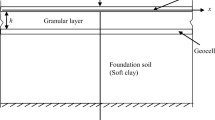Abstract
Several series of laboratory California bearing ratio (CBR) tests have been conducted to evaluate the influence of geosynthetics on load bearing behaviour of railway track formations over clay subgrade. The effects of subgrade strength, subballast thickness, placement depth of geogrid reinforcement, number of geogrid layers and geotextile at subballast base have been brought out. With a layer of geogrid in the subballast, the increase in bearing resistance and stiffness of the track bed can be as high as 115% and 83% in case of strong subgrade and 97% and 61% for weak subgrade, respectively. An additional increase in CBR due to four layers of geogrid can be as high as 35% and 59%, for strong and weak subgrade condition, respectively. The CBR test parameters were correlated with the plate load tests parameters, through regression analysis. The obtained equations are found to be reasonably good in predicting the subgrade modulus and the strain modulus values of the track beds.



















Similar content being viewed by others
References
Li D, Selig ET (1998) Method for railroad track foundation design. I: development. J Geotech Geoenviron Eng ASCE 124(4):316–322
Jain VK, Keshav K (1999) Stress distribution in railway formation-a simulated study. In: Proceeding 2nd international symposium on pre-failure deformation characteristics of geomaterials–IS Torino, vol 99 pp 653–658
RDSO (2007) Guidelines for blanket layer provision on track formation. RDSO-GE-0011 Research design and standard organisation, Ministry of Railways, New Delhi
Koerner RM (1990) Designing with Geosynthetics. Prentice Hall, New Jersey
Guido VA, Chang DK, Sweeney MA (1986) Comparison of geogrid and geotextile reinforced earth slabs. Can Geotech J 23(4):435–440. https://doi.org/10.1139/t86-073
Das BM, Khing KH (1994) Foundation on layered soil with geogrid reinforcement-effect of a void. Geotext Geomembr 13(8):545–553. https://doi.org/10.1016/0266-1144(94)90018-3
Gabr MA, Hart JH (2000) Elastic modulus of geogrid-reinforced sand using plate load tests. Geotech Test J ASTM 23(2):245–250. https://doi.org/10.1520/GTJ11049J
Alawaji HA (2001) Settlement and bearing capacity of geogrid-reinforced sand over collapsible soil. Geotext Geomembr 19(2):5–88. https://doi.org/10.1016/S0266-1144(01)00002-4
Zhou H, Wen X (2008) Model studies on geogrid or geocell reinforced sand cushion on soft soil. Geotext Geomembr 26(3):231–238. https://doi.org/10.1016/j.geotexmem.2007.10.002
Dash SK, Majee A (2021) Geogrid reinforcement for stiffness improvement of railway track formation over clay subgrade. Int J Geomech ASCE 21(9):1–19. https://doi.org/10.1061/(ASCE)GM.1943-5622.0002128
IRC-37 (2018) Guidelines for the design of flexible pavements. IRC: 37–2018, Indian Roads Congress, New Delhi
Tolou Kian AR, Sadeghi J, Zakeri J (2020) Influences of railway ballast sand contamination on loading pattern of pre-stressed concrete sleeper. Construct Build Mater 233:117324. https://doi.org/10.1016/j.conbuildmat.2019.117324
IS 1498 (1970) Classification and identification of soils for general engineering purposes. Bureau of Indian Standards, New Delhi
IS, 2720–8 (1983) Methods of test for soils: determinaion of water content-dry density relation using heavy compaction. Bureau of Indian Standards, New Delhi
IS, 2720–11 (1993) Methods of test for soils: Determination of the shear strength parameters of a specimen tested in unconsolidated undrained triaxial compression without measurement of pore water pressure. Bureau of Indian Standards, New Delhi
ASTM D6637, D6637M (2015) Standard test method for determining tensile properties of geogrids by the single or multi-rib tensile method. ASTM, West Conshohocken, PA
ASTM D4595 (2011) Standard test method for tensile properties of geotextiles by the wide-width strip method. ASTM, West Conshohocken, PA
Araya A, Molenaar A, Houben L (2010) Characterization of unbound granular materials using repeated load CBR and triaxial testing. In: Paving materials and pavement analysis pp 355-363
IS 2720–16 (1987) Method of test for soil: Laboratory determination of CBR. Bureau of Indian Standards, New Delhi
Terzaghi K (1943) Theoretical Soil Mechanics. John Wiley & Sons Inc, New York
Wyroslak M (2017) Establishing relationships between parameters of the controlled compaction soil by using various in-situ tests. IOP Conf Ser Mater Sci Eng 245:022041. https://doi.org/10.1088/1757-899X/245/2/022041
Funding
The experiments were carried out through funding from IIT Kharagpur, under laboratory grant.
Author information
Authors and Affiliations
Corresponding author
Ethics declarations
Conflict of interest
The authors declare that there is no conflict of interest.
Additional information
Publisher's Note
Springer Nature remains neutral with regard to jurisdictional claims in published maps and institutional affiliations.
Rights and permissions
Springer Nature or its licensor (e.g. a society or other partner) holds exclusive rights to this article under a publishing agreement with the author(s) or other rightsholder(s); author self-archiving of the accepted manuscript version of this article is solely governed by the terms of such publishing agreement and applicable law.
About this article
Cite this article
Dash, S.K., Majee, A. A Study on CBR of Railway Track Foundations with Geosynthetic Reinforcement. Indian Geotech J 53, 744–760 (2023). https://doi.org/10.1007/s40098-023-00710-x
Received:
Accepted:
Published:
Issue Date:
DOI: https://doi.org/10.1007/s40098-023-00710-x




